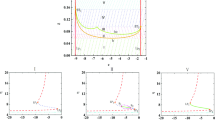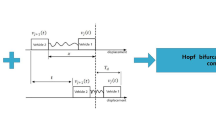Abstract
Based on realistic traffic conditions, the macroscopic traffic flow model that considers the driver’s anticipation and traffic jerk effect is improved, and the bifurcation theory is used to describe and predict nonlinear traffic phenomena on the road from the perspective of global stability. Firstly, the linear stability conditions and the Korteweg–de Vries–Burgers equation are derived using linear and nonlinear methods to characterize the evolution of traffic flow. The type and stability of the equilibrium solution are discussed using the bifurcation analysis method, and the conditions of existence of the Hopf bifurcation and saddle-node bifurcation are proved. Numerical simulations show that the model can describe the complex nonlinear dynamic phenomena observed on the road. The bifurcation analysis will be helpful for improving our understanding of stop-and-go and sudden changes in stability in real traffic flow.














Similar content being viewed by others
REFERENCES
Karakhi, A., Laarej, A., Khallouk, A., Lakouari, N., and Ez-Zahraouy, H., Car accident in synchronized traffic flow: a stochastic cellular automaton model, Int. J. Mod. Phys. C, 2021, vol. 32, no. 1.
Vranken, T., Sliwa, B., Wietfeld, C., and Schreckenberg, M., Adapting a cellular automata model to describe heterogeneous traffic with human-driven, automated, and communicating automated vehicles, Phys. A, 2021, vol. 570, no. 1.
Yang, Q.L., Modelling the variation and uncertainty problem of right-turn-on-red queue in a variety of conflicting environments, Appl. Math. Model., 2023, vol. 116, pp. 415‒440.
Ai, W.H., Zhu, J.N., Zhang, Y.F., Wang, M.M., and Liu, D.W., Bifurcation control analysis based on continuum model with lateral offset compesation, Phys. A, 2023, vol. 624, p. 128961.
Ai, W.H., Ma, Y.F., and Liu, D.W., Bifurcation analysis based on new macro two-velocity difference model, Int. J. Geom. Methods M, 2022, vol. 19, no. 14.
Bando, M., Hasebe, K., Nakayama, A., Shibata, A., and Sugiyama, Y., Dynamical model of traffic congestion and numerical simulation, Phys. Rev. E, 1995, vol. 51, no. 2, pp. 1035‒1042.
Helbing, D., Derivation of non-local macroscopic traffic equations and consistent traffic pressures from microscopic car-following models, C.I.M.E. Summer School, 2009, vol. 69, no. 4, pp. 539‒548.
Yu, X., Analysis of the stability and density waves for traffic flow, Chin. Phys. B, 2002, vol. 11, no. 11, pp. 1128‒1134.
Liu, D., Shi, Z.K., and Ai, W.H., An improved car-following model accounting for impact of strong wind, Math. Probl. Eng., 2017, vol. 2017, no. 10, pp. 1‒12.
Lighthill, M.J. and Whitham, G.B., On kinematic waves. II. A theory of traffic flow on long crowded roads, Proc. R. Soc. A: Math., Phys. Eng. Sci., 1955, vol. 229, no. 1178, pp. 317‒345.
Richards, P.I., Shock waves on the highways, Oper. Res., 1956, vol. 4, no. 1, pp. 42‒51.
Payne, H.J., Freflo: a macroscopic simulation model of freeway traffic, Transportation Research Record, Transportation Research Board, 1979, issue 772.
Whitham., G.B., Linear and Nonlinear Waves, New York: Wiley-Intersci., 1974.
Aw, A. and Rascle, M., Resurrection of second order models of traffic flow, Siam J. Appl. Math., 2000, vol. 60, no. 3, pp. 916‒938.
Rascle, M., An improved macroscopic model of traffic flow: derivation and links with the Lighthill–Whitham model, Math. Comput. Model., 2002, vol. 35, no. 5, pp. 581‒590.
Zhang, H.M., A theory of nonequilibrium traffic flow, Transp. Res., Part B: Methodol., 1998, vol. 32, no. 7, pp. 485‒498.
Jiang, R., Wu, Q., and Zhu, Z., A new continuum model for traffic flow and numerical tests, Transp. Res., Part B: Methodol., 2002, vol. 36, no. 5, pp. 405‒419.
Kiselev, A.B., Kokoreva, A.V., Nikitin, V.F., and Smirnov, N.N., Mathematical modelling of traffic flows on controlled roads, J. Appl. Math. Mech., 2004, vol. 68, no. 6, pp. 933‒939.
Kiselev, A.B., Kokoreva, A.V., Nikitin, V.F., and Smirnov, N.N., Mathematical simulation of two-lane traffic flow controlled by traffic lights, Moscow Univ. Mech. Bull., 2006, vol. 61, no. 4, pp. 1‒7.
Kiselev, A.B., Nikitin, V.F., Smirnov, N.N., and Yumashev, M.V., Irregular traffic flow on a ring road, J. Appl. Math. Mech., 2000, vol. 64, no. 4, pp. 627‒634.
Bogdanova, A., Smirnova, M.N., Zhu, Z.J., and Smirnov, N.N., Exploring peculiarities of traffic flows with a viscoelastic model, Transportmetrica ‒ Transp. Sci., 2015, vol. 11, no. 7, pp. 561‒578.
Smirnova, M.N., Bogdanova, A.I., Zhu, Z., and Smirnov, N.N., Traffic flow sensitivity to visco-elasticity, Theor. Appl. Mech. Lett., 2016, vol. 6, no. 4, pp. 182‒185.
Zhang, Y.L., Smirnova, M.N., Bogdanova, A.I., Zhu, Z.J., and Smirnov, N.N., Travel time prediction with viscoelastic traffic model, Appl. Math. Mech.-Engl., 2018, vol. 39, no. 12, pp. 1769‒1788.
Zhang, Y.L., Smirnova, M.N., Bogdanova, A.I., Zhu, Z.J., and Smirnov, N.N., Travel time estimation by urgent-gentle class traffic flow model, Transp. Res. B. ‒ Meth., 2018, vol. 113, pp. 121‒142.
Hu, Z.J., Smirnova, M.N., Zhang, Y.L., Smirnov, N.N., and Zhu, Z.J., Estimation of travel time through a composite ring road by a viscoelastic traffic flow model, Math. Comput. Simul., 2021, vol. 181, pp. 501‒521.
Huang, Z.M., Smirnova, M.N., Bi, J.R., Smirnov, N.N., and Zhu, Z.J., Analyzing roadway work zone effects on vehicular flow in a freeway ring, Int. J. Mod. Phys. C, 2023, vol. 34, no. 4.
Hu, Z.J., Smirnova, M.N., Smirnov, N.N., Zhang, Y.L., and Zhu, Z.J., Impacts of down-up hill segment on the threshold of shock formation of ring road vehicular flow, Adv. Appl. Math. Mech., 2023, vol. 15, no. 5, pp. 1315‒1334.
Li, Z.M., Smirnova, M.N., Zhang, Y.L., Smirnov, N.N., and Zhu, Z.J., Numerical exploration of freeway tunnel effects with a two-lane traffic model, Simul. T. Soc. Mod. Sim., 2023, vol. 99, no. 1, pp. 55‒68.
Li, Z.M., Smirnova, M.N., Zhang, Y.L., Smirnov, N.N., and Zhu, Z.J., Tunnel speed limit effects on traffic flow explored with a three lane model, Math. Comput. Simul., 2022, vol. 194, pp. 185‒197.
Schot, S.H., Jerk: the time rate of change of acceleration, Am. J. Phys., 1998, vol. 46, no. 11, pp. 1090‒1094.
Redhu, P. and Siwach, V., An extended lattice model accounting for traffic jerk, Phys. A, 2018, vol. 492, pp. 1473‒1480.
Liu, Y., Cheng, R.J., Lei, L., and Ge, H.X., The influence of the non-motor vehicles for the car-following model considering traffic jerk, Phys. A, 2016, vol. 463, pp. 376‒382.
Sun, F.X., Wang, J.F., Cheng, R.J., and Ge, H.X., An extended heterogeneous car-following model accounting for anticipation driving behavior and mixed maximum speeds, Phys. Lett. A, 2018, vol. 382, no. 7, pp. 489‒498.
Wan, J., Huang, X., Qin, W.Z., Gu, X.G., and Zhao, M., An Improved lattice hydrodynamic model by considering the effect of backward-looking and anticipation behavior, Complexity, 2021, vol. 2021, p. 4642202.
Tian, J.F., Yuan, Z.Z., Jia, B., Li, M.H., and Jiang, G.J., The stabilization effect of the density difference in the modified lattice hydrodynamic model of traffic flow, Phys. A, 2012, vol. 391, no. 19, pp. 4476‒4482.
Zhao, M., Sun, D.H., and Tian, C., Density waves in a lattice hydrodynamic traffic flow model with the anticipation effect, Chin. Phys. B, 2012, vol. 21, no. 4, pp. 623‒628.
Yu, L. and Zhou, B.C., The burgers equation for a new continuum model with consideration of driver’s forecast effect, J. Appl. Math., 2014, vol. 2014, pp. 1‒7.
Li, Z.B., Traveling Wave Solution of Nonlinear Mathethematical Physics Equations, Science Press, 2007.
Lai, L.L., Cheng, R.J., Li, Z.P., and Ge, H.X., The KdV–Burgers equation in a modified speed gradient continuum model, Chin. Phys. B, 2013, vol. 22, no. 6, pp. 293‒297.
Liu, H.Q., Zheng, P.J., Zhu, K.Q., and Ge, H.X., KdV–Burgers equation in the modified continuum model considering anticipation effect, Phys. A, 2015, vol. 438, pp. 26‒31.
Ai, W.H., Zhang, T., and Liu, D.W., Bifurcation analysis of macroscopic traffic flow model based on the influence of road conditions, Appl. Math.-Czech., 2023, vol. 68, no. 4, pp. 499‒534.
Ai, W.H., Research on Branch Analysis Method of Traffic Flow Nonlinear Phenomenon, Northwestern Polytechnical Univ., 2016.
Igarashi, Y., Itoh, K., Nakanishi, K., Ogura, K., and Yokokawa, K., Bifurcation phenomena in the optimal velocity model for traffic flow, Phys. Rev. E, 2001, vol. 64, no. 4.
Li, T., Nonlinear dynamics of traffic jams, Phys. D, 2005, vol. 207, no. 1, pp. 41‒51.
Delgado, J. and Saavedra, P., Global bifurcation diagram for the Kerner-Konhauser traffic flow model, Int. J. Bifurcation Chaos, 2015, vol. 25, no. 5.
Ai, W.H., Shi, Z.K., and Liu, D.W., Bifurcation analysis of a speed gradient continuum traffic flow model, Phys. A, 2015, vol. 437, pp. 418‒429.
Cheng, L.F., Wei, X.K., and Cao, H.J., Two-parameter bifurcation analysis of limit cycles of a simplified railway wheelset model, Nonlin. Dyn., 2018, vol. 93, no. 4, pp. 2415‒2431.
Ai, W.H., Zhu, J.N., Duan, W.S., and Liu, D.W., A new heterogeneous traffic flow model based on lateral distance headway, Int. J. Mod. Phys. B, 2021, vol. 35, no. 23, pp. 1‒19.
Ai, W.H., Li, N., Duan, W.S., Tian, R.H., and Liu, D.W., Bifurcation analysis of a modified continuum traffic flow model considering driver’s reaction time and distance, Int. J. Mod. Phys. C, 2023, vol. 34, no. 3.
Liu, G., Lyrintzis, A., and Michalopoulos, P., Improved high-order model for freeway traffic flow, Transp. Res. Rec., 1998, vol. 1644, no. 1, pp. 37‒46.
Kurtze, D.A. and Hong, D.C., Traffic jams, granular flow, and soliton selection, Phys. Rev. E, 1995, vol. 52, no. 1, pp. 218‒221.
Nagatani, T., The physics of traffic jams, Rep. Prog. Phys., 2002, vol. 65, no. 9, pp. 1331‒1386.
Helbing, D. and Tilch, B., Generalized force model of traffic dynamics, Condens. Matter, 1998, vol. 58, no. 1, pp. 133‒138.
Berg, P. and Woods, A., On-ramp simulations and solitary waves of a car-following model, Phys. Rev. E, 2001, vol. 64, no. 3.
Aulbach, B. and Wanner, T., The Hartman–Grobman theorem for Caratheodory-type differential equations in Banach spaces, Nonlin. Anal.-Theor., 2000, vol. 40, no. 1, pp. 91‒104.
Kerner, B.S. and Konhuser, P., Cluster effect in initially homogeneous traffic flow, Phys. Rev. E, 1993, vol. 48, no. 4, pp. 2335‒2338.
Cao, J.F., Han, C.Z., and Fang, X.W., Theory and Application of Nonlinear Systems, Xi’an Jiaotong Univ. Press, 2006.
Daganzo, C.F. and Laval, J.A., Moving bottlenecks: A numerical method that converges in flows, Transp. Res. B- Meth., 2005, vol. 39, no. 9, pp. 855‒863.
Shuming, R., Traffic speed measurement based on video, Comput. Commun., 2007, vol. 25, pp. 90‒93.
ACKNOWLEDGMENTS
The authors would like to thank the anonymous referees and the editor for their valuable opinions.
Funding
This work is partially supported by the National Natural Science Foundation of China under the Grants nos. 72361031 and 12275223 and the Qizhi Personnel Training Support Project of Lanzhou Institute of Technology (project no. 2018QZ-11) and the University Youth Doctoral Support Project of Gansu Province of China under the Grant no. 2023QB-049.
Author information
Authors and Affiliations
Corresponding author
Ethics declarations
The authors declared that they have no conflicts of interest in this work. We declare that we do not have any commercial or associative interest that represents a conflict of interest in connection with the work submitted.
Additional information
Publisher’s Note.
Pleiades Publishing remains neutral with regard to jurisdictional claims in published maps and institutional affiliations.
Rights and permissions
About this article
Cite this article
Ai, W.H., Xu, L., Zhang, T. et al. Bifurcation Analysis of the Macroscopic Traffic Flow Model Based on Driver’s Anticipation and Traffic Jerk Effect. Fluid Dyn 58, 1395–1419 (2023). https://doi.org/10.1134/S0015462823601249
Received:
Revised:
Accepted:
Published:
Issue Date:
DOI: https://doi.org/10.1134/S0015462823601249




